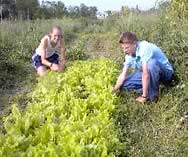5 Reasons to Choose Locally Grown Fruits and VegetablesThe health problems associated with the industrial urban diet are clearly worldwide in scope, and several national programs to raise public awareness are beginning to address these problems. However, an important missing element of this strategy may be waiting in our own backyards. There is ample evidence that eating lots of fruits and vegetables is good protection against many diseases. What is not always as well recognized is the special role of produce grown close to home. Locally grown fruits and vegetables have five important advantages: nutrition, flavor, variety, economics and environment. 1. Flavor
People who fondly remember the taste of fresh picked vegetables are not just being nostalgic. They are sweeter and this fact is especially important when introducing children to vegetables. Children who learn to enjoy vegetables when they are young usually will develop the habit of eating them all their lives. Increasingly, good restaurants and gourmet shops prefer locally grown produce when possible because the flavor is superior. This is a trend that may create a significant market for fresh specialty crops. 2. NutritionIdeally, crops are harvested at the point in the plant's development when the level of nutrients is highest. Immediately after harvest the nutritional value begins to fall. The decline can be fast or slow depending on the nutrient in question, the crop and on how that crop is handled. Produce shipped in from distant farms has two distinct nutritional disadvantages when compared to local produce. First, it is likely to spend a longer time losing nutritional value between harvest and eating; and secondly, it is usually picked well before its peak of nutrition so that it won't wilt or spoil before it is sold. 3. VarietyGrocery stores that carry a wider range of produce and exotic foods, such as mangoes and avocados, are gradually becoming more commonplace. It is interesting, however, to remember the enormous variety of locally grown fruits and vegetables that use to be available to us. A book on American apples and pears written at the time of the Civil War listed over 250 'common' varieties of apples and 180 varieties of pears. One of the great things about local produce is that you can get varieties that are chosen for their taste and nutrition, not for how well they hold up to mechanical harvest and shipping. 4. Economics
To get a sense of the impact of this food dependency on local economies, consider Massachusetts for example, where importing food results in an estimated $4 billion leaving the state yearly. A study showed that even a 20% increase in local food production would contribute $1 billion a year to that state's economy. Massachusetts has its particular situation with regard to production of and demand for fruits and vegetables. However, it is still clear from this study that increasing local food production could strengthen the local economy in many, if not all, fifty states. In the central Appalachia region of the country this issue has special importance because of the historical role of tobacco. Tobacco, long a cornerstone of this area's rural economy, is in decline as people become more aware of the negative impact of smoking on their health. Tobacco is a labor-intensive crop that receives a high price per pound. An acre or two of tobacco grown on the best land available was often enough to keep many small hill farms solvent and to create some local employment. As farmers look to replace tobacco, high quality fruits and vegetables are one of the most frequently mentioned options. Specialty fruits and vegetables require a great deal of hand labor but like tobacco, could have a high return per acre. Kentucky is the classical tobacco state where in 1998 fruits and vegetables made up less than one half of one percent of sales from Kentucky farms, while tobacco accounted for 26.8%. If some of the economic value of raising tobacco could be replaced by increasing production of fruits and vegetables both the rural economy and the general health of the people could benefit. 5. Environment
As we become more attuned to how our natural ecosystems function, the many indirect environmental costs of unnecessary transportation are becoming clearer. These include air pollution, noise, traffic congestion and global warming. Even in the heart of winter, we can produce lettuce and other cool weather crops in simple greenhouses for a small fraction of the environmental cost of shipping them from southern California or Mexico. While we may well continue to haul in oranges and bananas from more tropical climates, it seems environmentally irresponsible to continue importing vast amounts of produce that could be easily grown closer to home. |
 While good nutrition is important, most people eat foods for pleasure. It is the natural sugars and volatile compounds that give fresh picked vegetables their delicate and delicious flavors. In many vegetables, such as sweet corn and peas, these natural sugars begin converting into bland tasting starch as soon as they are separated from the plant. Greens, such as kale and collards, are sweetest and most flavorful after a frost. This is because the plants protect leaf tissues from freezing by converting stored starch into soluble sugars, which lower the temperature at which the plant sap will freeze. Another way that delicate flavors are lost from fruits and vegetables over time is from esters evaporating into the air. Produce shipped in from southern California or Mexico will never see a frost and much of their natural sugars and volatile flavors are lost in storage on the long trip to your table.
While good nutrition is important, most people eat foods for pleasure. It is the natural sugars and volatile compounds that give fresh picked vegetables their delicate and delicious flavors. In many vegetables, such as sweet corn and peas, these natural sugars begin converting into bland tasting starch as soon as they are separated from the plant. Greens, such as kale and collards, are sweetest and most flavorful after a frost. This is because the plants protect leaf tissues from freezing by converting stored starch into soluble sugars, which lower the temperature at which the plant sap will freeze. Another way that delicate flavors are lost from fruits and vegetables over time is from esters evaporating into the air. Produce shipped in from southern California or Mexico will never see a frost and much of their natural sugars and volatile flavors are lost in storage on the long trip to your table. One hundred years ago most states grew most of the food their citizens ate. Now almost all states, including agricultural ones, get the bulk of their food from outside their boundaries at a high cost. As more of our produce started coming from huge mechanized farms thousands of miles away, the economy of many rural communities suffered.
One hundred years ago most states grew most of the food their citizens ate. Now almost all states, including agricultural ones, get the bulk of their food from outside their boundaries at a high cost. As more of our produce started coming from huge mechanized farms thousands of miles away, the economy of many rural communities suffered. It has been estimated that each bite of food in the U. S. has been hauled an average of 1,300 miles from the farm to the market shelf before being eaten. Transport of fruits and vegetables is especially demanding on the environment. Being comprised of about 85% water, most fruits and vegetables have a very short shelf life and quickly lose economic as well as nutritional value during shipping. Because of this, much of the produce that is hauled across the U.S. is delivered in refrigerated trucks that require even more fuel per mile than ordinary transport. To put this in perspective, consider that every tractor-trailer load of produce grown in the eastern US instead of shipped in from southern California means 300 - 400 gallons of fuel that doesn't need to be drilled for, refined and burned.
It has been estimated that each bite of food in the U. S. has been hauled an average of 1,300 miles from the farm to the market shelf before being eaten. Transport of fruits and vegetables is especially demanding on the environment. Being comprised of about 85% water, most fruits and vegetables have a very short shelf life and quickly lose economic as well as nutritional value during shipping. Because of this, much of the produce that is hauled across the U.S. is delivered in refrigerated trucks that require even more fuel per mile than ordinary transport. To put this in perspective, consider that every tractor-trailer load of produce grown in the eastern US instead of shipped in from southern California means 300 - 400 gallons of fuel that doesn't need to be drilled for, refined and burned.